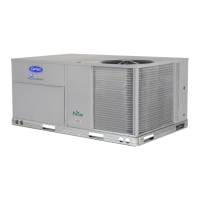20
HACR —
The amp rating of the HACR factory--installed option is
based on the size, voltage, indoor motor and other
electrical options of the unit as shipped from the fa ctory.
If field--installed accessories are added or changed in the
field (i.e., electric heat, power exhaust), the HACR may
no longer be of the proper amp rati ng and therefore will
need to be removed from the unit. See unit nameplate a nd
label on factory--installed HACR for the amp rating of the
HACR that was shipped with the unit from the factory.
See unit nam eplates for the proper fuse, HACR or
maximum over--current protection device required on t he
unit with field--installed accessories.
C12105
Fig. 25 -- H ACR Caution Label
Factory--Option Thru--Base Connections —
This service connection kit consists of a
1
/
2
--in electrical
bulkhea d connector and a 1
1
/
4
--in electrical bulkhead
connec tor, all factory--installed i n the e mbossed (raised)
section of the unit basepan in the condenser section. The
1
/
2
--in bulkhea d connector enables the low--voltage control
wires to pass through the basepan. The 1
1
/
4
--in electrical
bulkhea d connec tor allows the high--volt age power wires
to pass through the basepan. See Fig. 26.
LOW VOLTAGE
CONDUIT
CONNECTOR
HIGH VOLTAGE
CONDUIT
CONNECTOR
C13412
Fig. 26 -- Thru--Base Connection Fittings
Check ti ghtness of connector lock nuts before connecting
electrical conduit s.
Field--supplied and field--installed liquid--tight conduit
connec tors and conduit may be attac hed to the connectors
on the basepan. Pull correctly rated high voltage and low
voltage through appropriate conduits. Connect the power
conduit to the internal disconnect (if unit is so equipped)
or to the exte rnal disconnect (through uni t side panel ). A
hole must be field cut in the main control box bottom on
the left side so the 24--v control connections can be made.
Connect the control power c onduit to the unit control box
at this hole.
Units without Thru--Base Connections —
1. Install power wiring conduit through side panel open-
ings. Install conduit between disconnect and control
box.
2. Install power lines t o terminal connections as shown
in Fig. 16.
Field Control Wiring —
The 50HC unit requires an external temperature control
device. This device can be a thermostat (field--supplied) or a
Premier Lin kt contr oller (available as factory--ins talled
option or as field--ins talled acces s or y, for use on a Carr ier
Comfort Network
R
(CCN) or as a stand--alone control) or
the RTU Open Contro ller for Building Manag ement Systems
using non--CCN protocols (RTU Open controller is available
as a factory--installed option only).
Thermostat —
Select a Carrier--approved accessory thermostat. When
electric heat is installed in the 50HC unit, the thermostat
must be capable of energizing the G terminal (to energize
the Indoor Fan Contactor) whenever there is a space call
for heat (energizing the W1 terminal). The accessory
thermostats listed on the unit pri ce pages can provide this
signal but the y a re not configured to enable this signal as
shipped.
Install the accessory thermostat according to installation
instructions included with the accessory.
Locate the thermostat accessory on a solid wall in the
conditioned space to sense average temperature in
accordance with the thermostat installation instructions.
If the thermostat contains a logic circuit requiring 24--v
power, use a thermostat cable or equivalent single leads of
different colors with minimum of seven leads. If the
thermostat does not require a 24--v source (no “C”
connec tion required), use a thermostat cable or equivalent
with minimum of six leads. Check the thermostat
installation instructions for additional features which
might require additional conduc tors in the cable.
For wire runs up to 50 ft. (15 m), use no. 18 AWG
(American Wire Gage) insulated wire (35_C minimum). Fo r
50 to 75 ft. (15 to 23 m), use no. 16 AWG insulated wire
(35_C minimum). For over 75 ft. (23 m), use no. 14 AWG
insu lated wire (35_C minimum). All wire sizes larger than
no. 18 AWG cannot be directly connected to the thermostat
and will require a junction box and sp lice at the thermos tat.
See Fig. 27 for typical low--voltage control connections

